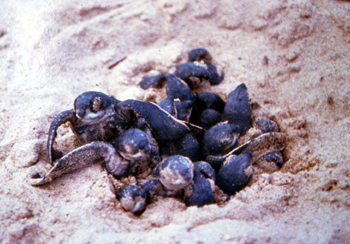20. Leaving the nest area
![]()

Extract from a lecture by the President of MEDASSET - Lily Venizelos
A sudden drop in temperature, usually at sunset, at night, or in the
early dawn hours, or even after a sudden shower, activates the baby
turtles to leave the nest and they immediately scramble out on to the
surface of the beach. This emergence into life is a second hatching. The
babies which are the first to be activated transmit the information to the
rest by their movements. If the activation is delayed and evacuation of
the nest begins when the sand has been heated by the sun, this same
mechanism can operate in reverse to deactivate the nest. The babies stay
under the surface waiting for the next activation. If, however, man should
intervene to activate the nest, even when the sand is hot, the evacuation
will start immediately, and if this happens during a hot day the
hatchlings are doomed to perish under the hot sun.
Little snouts poke up through the sand, suddenly, where they are not
expected, pushing up and sprouting like black mushrooms. The babies are
4-5 centimetres long and grey-black in colour. As soon as they leave the
sand, they begin a crazy rush towards the sea. Hundreds of hatchlings pour
out wildly in every direction and run and run.
Perhaps it is not only instinct which leads the small turtles so surely
towards the sea. There are two main reasons why they are guided on the
correct path towards the sea: the slope of the beach and the light on the
horizon in the centre of their field of view. In the same way the mother
turtles find their way back to the sea after nesting.
![]() Decide what to do next - click on the hatchling button next to your choice
Decide what to do next - click on the hatchling button next to your choice ![]()
